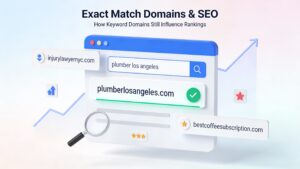Table of Contents
ToggleDefining an SEO Strategy
Over the past 24 years, I’ve come across different thoughts about B2B Brand and Strategy Building. While I thought this would be pretty straightforward to write about, I quickly realized that there are four parts to an SEO strategy:
- What is an SEO strategy
- How to create an SEO strategy (and why)
- How to tie metrics to an SEO Strategy
- Defining an SEO Strategy
- Executing on an SEO Strategy
Key to completing your strategy is knowing what Metrics to track in your Enterprise SEO Strategy.
So that the company – from the CEO down, and not the SEO manager up, is fully bought it into it, that they realize the value and benefit of being first in Google, that they know what they need to be number one for, and that its hard work but that they have the trust in the team that they will get there.
What Does an SEO Strategy Template Look like?
The number one failure for an Enterprise SEO agency is not knowing what the goal is – how big it is, and how long it takes to get there. In ad campaigns, with a budget, you know exactly how many clicks to expect and maybe even what the conversion rate is. When SEO marketing is deemed not to be working because the online lead count isn’t high enough, most people downgrade SEO as part of the marketing strategy, and this is wrong on both sides of the coin.
The second biggest reason is that companies treat SEO as free ads – they want to write ads that they expect they are entitled for and then ignore keywords that they don’t understand because they wouldn’t otherwise pay for. Combined – these two elements lead to a fast distrust of SEO. Meanwhile, their competitors, who aren’t talking about their SEO strategies are enjoying phenomenal results which they keep investing and optimizing in.
SEO as part of a Marketing Strategy
SEO’s place in Marketing Strategy is sometimes a placeholder, and sometimes it’s just an assumption. It’s critical for Marketing leaders and SEO Managers to clearly define what an SEO strategy is, without getting to the tactical level and articulating that to the management team.
I’m going to assume that Search is going to be your main organic and overall lead generator. SEO works incredibly well for about 85% of marketplaces and terribly for about 5%. There are certain industries where demand and awareness simply don’t exist and SEO takes a secondary role.
SEO Strategy Template
If your business is getting more than 30% of its leads from Google, then you need to consider SEO as a Primary and not a secondary or supporting strategy. The list for B2B SEO often looks like this:
- Google/Search (includes Google Ads)
- YouTube
- Web Forums (Reddit, Spiceworks, etc)
- Social Media
- TikTok
What does an SEO Strategy look like?
Some major misconceptions about SEO need to be addressed in the strategy. A strategy should:
- Set out the over-arching goal of what and why
- It should set the importance of it in the overall Marketing Strategy
- For example, if Organic SEO is 70% of your lead source (currently or intended) – it should be positioned in your Marketing Strategy as such
- Know Exactly who you want to be
- We want to be the X of our Industry
- We want to be the #1 in [search keyword]
- Sizing your SEO Strategy
SEO Strategy and Reporting
Reporting is key to measuring and keeping SEO strategies aligned. We have a free SEO Report Template that you can use to setup and track your own SEO Strategy.
Google Analytics
Google Analytics will give you a great starting point. Look or ask your digital marketing team for a breakdown of Brand and Traffic Channels.
Marketing Channel Data
If you’ve already got the data to analyze, then you should be able to see what % makeup Google and other digital channels send. While your Google data is probably the biggest, you might be tempted to think that other channels like LinkedIn, Twitter, Facebook, and others just aren’t being used to their full potential but the opposite is most likely to be true. In fact, as a B2B business, somewhere between 70-90% of your traffic should come from Google, Google Ads, and YouTube (collectively: the Google Platform).
The problem is – that the other channels just don’t generate traffic to the same scale. Instead, they focus on impressions and you have to decide, as a marketing leader, if this is a real or vanity metric.
Important Digital Channel Traffic Volumes to Know
According to sites like SimilarWeb, this is how web traffic flows:
- Google Search is the single largest web traffic source, driving well over 60% of global web traffic.
- Google drives 800% more traffic than ALL of the web’s social media platforms combined.
- The average top blog gets 70% of its traffic from search, of which 99% is organic and only a fraction – approximately 0.23% – is paid for ia Google Ads
- When you think about how much traffic you get, buy, or curate from other sources, like Referring sites such as blogs, aggregators, comparison sites, and forums, it bears well to think that they, in turn, get most of their traffic from Google.
Strategic SEO Campaign Template Stages
There are three pivotal stages at which an SEO strategy is required that are significantly different from each other:
- Developing a brand new startup or go-to-market
- Building a strategy for a company with a small SEO Campaign
- Developing a High-Performance Strategy for a company dependent on SEO/Google
The Industry Standard for an SEO Strategy Template
The most common SEO strategy appears to be “fine, let’s do SEO.” The ramifications of this quickly become apparent:
- Lack of budget
- Ad hoc approach
- Sporadic Content Development
- Resources borrowed or co-developed with other campaigns.
- Bad Assumptions and Misconceptions
Some of the failures in communication and understanding between the marketing execution and the rest of the leadership/executive team are rooted in the misconceptions and assumptions the leadership team has. Even if they want to do well in Google, they need a framework that sets out what they want to do and what obstacles exist.
SEO Strategy Template for Authority
Earning Authority in SEO is the most important and complex part of SEO. Our number one proviso here is: do not buy backlinks or participate in backlink schemes. This means putting together a slow, authority, and relevance-based link-building and profile-developing program.
Breaking Down Assumptions:.
Stage 1
The most common and frequently unsaid myths about SEO are:
- SEO is free
- SEO is an indirect result of other marketing
- Content Marketing is the new SEO
- SEO is dead
- SEO is a dark art
- SEO is about doing special things to web pages
- Content is content – whether its for SEO or other
- SEO is all about hard work, being creative and opportunistic, learning, executing, benchmarking, and improving.





